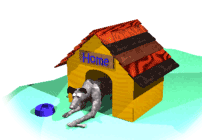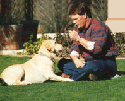 |
|||
|
|
 |
 |
|
|
 |
|||
|
Down/Stay - The Whole Shebang : Part ll (Down/Stay, Continued.) So far, we have shaped a "down" and taken the behavior up to the point of varying the reinforcement. We have primarily focused on creating a "quick" down, but there are several additional criteria that have to be added before we can be satisfied with the behavior. Obviously we need to build duration and add distractions to insure good performance. While most people move immediately to insuring the "stay", there is an alternative that can offer additional stability to "down/stay". The alternate strategy is to establish a really good "down wherever you are", before focusing on duration. For those of you who have had trouble with the long down, adding the distance factor before building duration, can make the dog far more comfortable during competition. There are several ways to teach "down from a distance". Here are six suggestions for developing that aspect of "down/stay". 1) If you are starting a puppy or dog with no formal training, you can reinforce any lying down, regardless of where it happens. This will increase the likelihood that the behavior will occur, which will make it predictable enough to attach a cue. Since the pup/dog has never experienced the requirement of coming to your location in order to be reinforced, the tendency to move toward you in response to the cue "down" simply never develops. This is an elegant way to shape the behavior, but requires confidence in the process. If you have doubts about the process of using positive reinforcement for strengthening behaviors, this is a very good exercise to increase your skill, knowledge and confidence. 2) Practice "down" for about 15 minutes and very gradually shift your position, relative to the dog. As the dog starts to get the hang of it, there will be some repetitions when the dog makes a move toward you - say "wrong" and try it again. 3) Practice "down" for about 15 minutes. End the session and leave the training area. Wait until the dog is about four or five feet away from you and give the cue that you are using for "down." If the dog takes a step toward you, say "wrong" - which ends the repetition. If the dog drops, click and give a big reinforcement, including lots of praise, affection and play. 4) Sit in a comfortable chair with a soda, some snacks, and a clicker and turn on your favorite TV show. If you've taught your dog to bump a stuffed toy or pillow, as I suggested in my column on "targeting", put the item in front of the television, sit back and relax. If your dog goes to investigate the target, click and toss a treat to the dog. Try to make the treat travel far enough so there is no need for the dog to return to you. Do this about 10 times, so that your dog starts bumping the target consistently and then waiting for the click/treat that is about to come sailing across the room. After a few repetitions of this, the behavior will evolve into a set pattern -- the dog will proceed quickly to the target, bump it and then look back at you, expectantly. Once you consistently see this pattern, it is time to inject the real object of the task. Your next step is to watch the "go-out/touch/pause" and say "down," during the pause. If the dog does, click and offer a big jackpot. If the dog takes a step toward you, or stands still, say "wrong" and go back to the "go-out/touch/pause" for a few more repetitions, then try the "down" again. 5) Variation of #4: Teach the dog to touch a close target (pillow, stuffed toy, target stick) and then "down." As you click for the successful "down", place the treat on the ground, in front of you. Initially you are standing only a foot away from the target, so the dog is making a quick bump, hears the click and plucks the treat from the ground. (Don't panic, if this causes the dog to sniff the ground during training, you merely have to say "NO!" when it is inappropriate and the problem will go away.) Over a series of repetitions, take "baby steps" backwards - you will gently create a "go-out" as the dog returns to you to get the treat, and then moves back to the target. This variation makes the "touch/down" automatic, which makes "down at a distance" easy. If you use this method, you will have to remove the target later, while retaining the criterion of "down, wherever you are." The secret of this variation is to do many repetitions, quickly. This insures that when you remove the target there is a high probability that the dog will "down" in response to the sound of the word "down". 6) Start the dog in a sitting position. Take a step backward. Give the cue, "down." If the dog does the behavior, click and treat. If not, say "wrong" and do nothing. Continue until the dog will go from a sit to a down comfortably, regardless of your location. Use your targets to get the dog to go away from you. This will allow you to gradually increase the distance. Regardless of which variation you use, the underlying theme is simple - get some aspect of the behavior happening consistently and then add the new criterion. In the case of "down, wherever you are", you can easily use your target training (a previously learned behavior) to create the distance. Once you develop some momentum with "distance", including the additional criterion is merely a matter of practice and patience, on your part. Start adding the "down at a distance" to your dog's daily routine. Start asking for it when the dog is facing you, facing away from you, at a distance and up close. The ultimate goal is to clearly delineate that "down" is connected to hearing the cue or seeing the hand signal, rather than being in any particular "position" relative to you. Now that you have a consistent "down from a distance", it's time to put some flair into the behavior. My favorite variation is to teach "down, on cue, even if we are moving." In essence, you are teaching a version of "lie there", one of the core behaviors of herding. Our goal in this process is to take the dog's knowledge beyond the bare minimum required by the rules of competition, so that you'll have some extra control at the top end of your dog's performance. To get started with "drop while moving", start walking slowly with your dog. Wait until the dog is not looking at you and say "down". If the dog drops, click and treat. If the dog stops, but doesn't drop, click and treat. If the dog takes an additional step, say "wrong" and try it again. If you have more than five failures in a row, you may have to use a different strategy to achieve your goal. Since your dog didn't do a moving drop the first time, you need to drop your standards and get some aspect of the behavior happening. You can do this in two ways. First, you can teach "stop, while standing, even if I continue walking" and add the "down" later. Second, you can start from a modified "heel" position, with the dog standing. As you step off, say "down". Move as slowly as possible to make your movement barely a part of the process. As the dog consistently drops to your command, speed up the process. Next, try it while moving. For many of you who are more familiar with traditional training, that last suggestion will probably give you the "willies". The obvious assumption is that the dog will confuse this with stepping off at the start of a heel. There are a number of reasons why this is not a problem. 1) You didn't say "heel" - that makes the two situations obviously different. 2) Within a very few repetitions, you will be doing it while moving and will never need to go back to doing it while slowly stepping off. 3) Requiring a dog to make MORE accurate discriminations than are required by traditional standards is, as Martha Stewart likes to say, "a good thing." Demanding more from your dog is the whole idea of learning new methods - if you settle for the path of least resistance, you will never realize your dog's full potential. Once you have consistent "down from a distance" and "down on cue, even if we are moving", re-introduce the criterion of "quick". Be willing to practice this in a number of settings, other than just a simulated obedience competition. Start asking the dog to drop in any setting, at any distance, whenever you happen to ask for it. Once your dog is comfortable with doing quick downs from a distance, you will be ready to add "stay" to the equation.
Go to Prior Article | Go to First Article | Go to Next Article | Back to Clicker Project Index |
|||
|
Copyright 1994-2013 Gary Wilkes. All rights reserved.
|
|||

